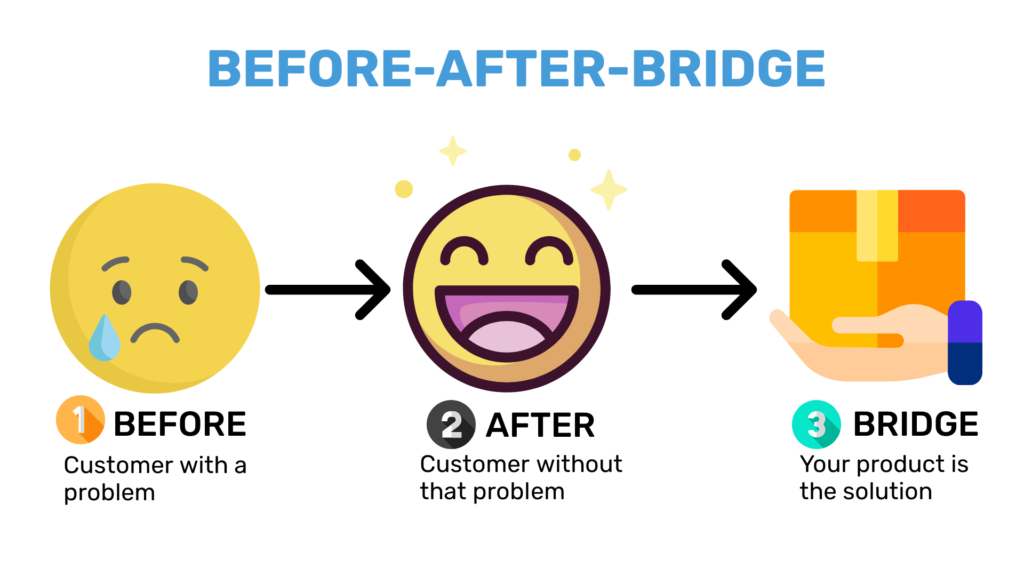Entering the field of marketing can feel like stepping into a labyrinth. New concepts, strategies, and tools seem to lurk around every corner. However, mastering these tools and learning how to combine them can lead you towards marketing success. We previously talked about the AIDA and PAS frameworks, with the third being the BAB (Before-After-Bridge) framework. It is a powerful technique often used in copywriting and advertising to convince prospects of the benefits of a product or service.
This guide will teach you how to supercharge the BAB framework, by explaining how it works, and when it's best to use it. We'll then delve into how AI, specifically a tool named ChatGPT developed by OpenAI, can be used to enhance the BAB framework, transforming it into a potent weapon in your marketing arsenal.
Understanding the BAB Framework
To effectively use the BAB framework in your marketing strategies, it's vital to understand what it is and how it works. BAB stands for Before-After-Bridge, a formula that expert copywriters often use to lead their audience from a problem (Before) to a solution (After) via their product or service (Bridge).

Before: This is where you paint a picture of your prospect's current problem or pain point. The idea is to evoke an emotional response, such as frustration or dissatisfaction, that resonates with the audience's experience.
After: This is the utopia, the world where your prospect's problem no longer exists because they have used your product or service. It's the contrast with the 'Before' state that makes this so compelling. The objective is to make your audience yearn for this better scenario.
Bridge: This is your product or service, the magic wand that will take your audience from their 'Before' state to the desired 'After' state. The bridge should clearly explain how your product or service can resolve the problem highlighted in the 'Before' stage.
Suppose you're marketing a fitness app. In the 'Before' stage, you might describe the prospect's struggle to keep up with regular workouts due to a busy schedule. In the 'After' stage, you'd illustrate a world where workouts are conveniently integrated into their daily routine, leading to a healthier, happier life. The 'Bridge' would then introduce your fitness app, explaining how its features can help the prospect efficiently manage workouts despite a busy schedule.
The BAB framework is a powerful tool in the copywriter's arsenal because it addresses human nature. We are wired to avoid pain (Before) and seek pleasure (After), and we're always on the lookout for solutions (Bridge) to make that transition. Now, imagine coupling this natural psychological tendency with the computational power of AI like ChatGPT.
When to Use the BAB Framework
The BAB framework can be used effectively across a multitude of marketing platforms - from email campaigns, landing pages, blog posts to social media posts. But its most influential use is when you want to highlight the transformative power of your product or service.
BAB is excellent when marketing products or services that solve a significant problem for the prospect. If your product or service can create a vivid contrast between the problem (Before) and the solution (After), then BAB is an excellent framework to use.
When is the best time to use the BAB framework? It excels in situations where you need to create a compelling narrative about transformation. It is the "Cinderella story" of marketing techniques. If your product or service can dramatically improve a situation or solve a major problem, then the BAB framework is an optimal choice.
That said, using the BAB framework requires a deep understanding of your audience's problems, desires, and the unique benefits your product or service offers. Only then can you craft a story that will resonate with them and lead them towards the desired action.
In the next section, we'll discuss how we can use ChatGPT to enhance the BAB framework, adding a powerful dimension to your marketing toolkit.
Enhancing the BAB Framework with ChatGPT
Now that we understand the BAB framework and its applications, let's take a look at how we can combine it with a powerful tool like ChatGPT to amplify its effectiveness.
ChatGPT, developed by OpenAI, is a language model that uses machine learning to generate human-like text. It's designed to assist in tasks ranging from drafting emails to writing code and, in this case, generating marketing copy.
Bridging BAB and ChatGPT
To use ChatGPT in conjunction with the BAB framework, you first need to define the 'Before' and 'After' states you want to present. Once you've done that, you can feed these into ChatGPT as a prompt, allowing the AI to generate the 'Bridge' part of the framework.
For example, if we stick to our fitness app scenario, your prompt to ChatGPT might look like this:
Utilizing the BAB framework, your mission is to construct three distinct 'bridges.' These 'bridges' represent the transformative solutions facilitated by our fitness app that will transition a busy professional from the 'Before' state to the 'After' state.
Your bridges should detail the features and benefits of our fitness app, and how they catalyze this transformation. Make sure that the bridges are clearly articulated and persuasive to encourage potential users to see our fitness app as a viable solution to their exercise challenges.
Before: Consider a busy professional who struggles to uphold a consistent workout regimen due to a demanding schedule.
After: Visualize the same professional now seamlessly incorporating workouts into their daily routine, leading to a lifestyle marked by balance, health, and happiness.
The AI would then generate a text that fills in the 'Bridge' part, explaining how your fitness app can facilitate the transition from the 'Before' state to the 'After' state.
ChatGPT can generate multiple responses, allowing you to choose the one that best fits your brand voice and marketing goals. This can be a powerful ally in the creative process, providing you with new angles and phrasing you might not have thought of.
Examples in Action
Let's see how this works in practice. After prompting ChatGPT as described above, the AI might generate a 'Bridge' like this:
"Bridge: With our fitness app, the busy professional can access quick, efficient workouts tailored to their schedule. The app sends reminders, keeps track of progress, and adjusts workouts based on available time, ensuring the professional can stay healthy and active, regardless of how busy they are."
Alternatively, the AI might offer another perspective:
"Bridge: Our fitness app acts as a personal trainer in the professional's pocket, providing flexible, time-efficient workouts that can be completed anywhere, anytime. Its features ensure the professional stays on track with their fitness goals, even amidst a hectic schedule."
These examples illustrate how the integration of the BAB framework with ChatGPT can offer unique, compelling marketing narratives that resonate with your target audience.
In the next section, we'll delve into how entry-level marketers can leverage this powerful combination to elevate their marketing game.
Key takeaway: ChatGPT can supercharge the BAB framework by providing unique and compelling 'Bridge' text, offering fresh perspectives and accelerating the content creation process.
ChatGPT and BAB: A Powerful Tool for Entry-Level Marketers
As an entry-level marketer, you're constantly looking for ways to improve your marketing game and make your campaigns more effective. Combining the BAB framework with the AI capabilities of ChatGPT can provide an innovative and efficient way to create compelling marketing narratives.
Simplified Content Creation
For those starting in marketing, coming up with captivating and convincing content can be a daunting task. The union of BAB and ChatGPT simplifies this process. By understanding your audience's 'Before' state and visualizing the desired 'After' state, you can use ChatGPT to generate the 'Bridge' content, showcasing your product or service as the solution.
Amplified Creativity
Even for the most creative among us, there are moments when we struggle to find the right words. That's where ChatGPT comes in handy. By generating various versions of the 'Bridge' content, the AI can spark your creativity, offering fresh perspectives and narratives.
Consistent Learning
Lastly, as a tool built on machine learning, ChatGPT itself is continually learning and improving. As you interact with it more, it gets better at understanding your preferences and delivering content that aligns with your marketing goals. This continuous evolution makes it a reliable companion for your marketing journey.
To conclude, the combination of the BAB framework and ChatGPT presents a powerful tool for entry-level marketers. It offers a unique way to create compelling marketing copy, amplifies creativity, and supports consistent learning. Harness the power of this dynamic duo to create marketing narratives that truly resonate with your audience.
---
Further reading








